1988 PONTIAC FIERO key
[x] Cancel search: keyPage 725 of 1825
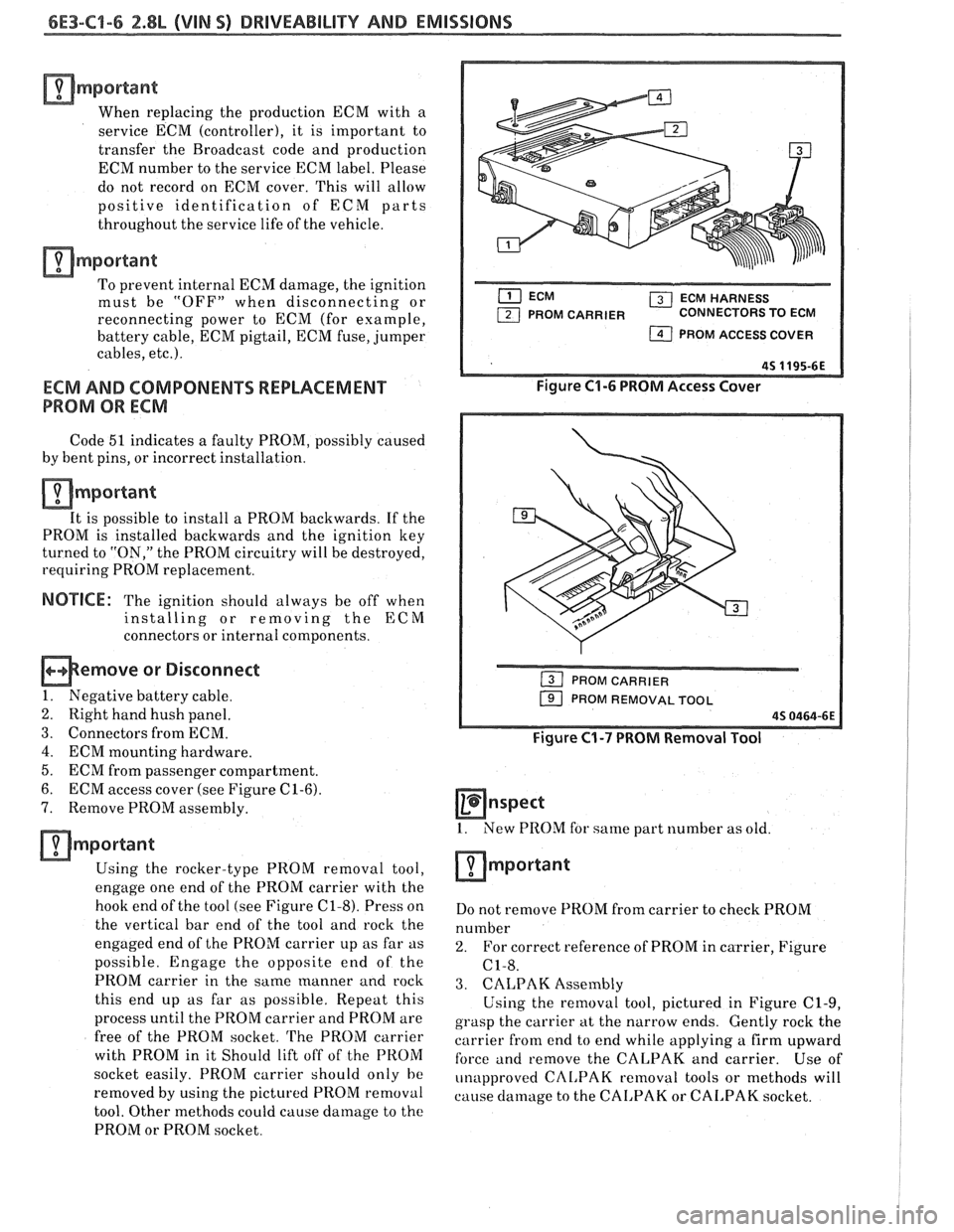
6E3-C1-6 2.8L (VIM O) DRlVEABlLlTY AND EMISSIONS
amportant
When replacing the production ECM with a
service ECM (controller), it is important to
transfer the Broadcast code and production
ECM number to the service ECM label. Please
do not record on ECM cover. This will allow
positive identification of ECM parts
throughout the service life of the vehicle.
amportant
To prevent internal ECM damage, the ignition
must be "OFF" when disconnecting or
reconnecting power to ECM (for example,
battery cable, ECM pigtail, ECM fuse, jumper
cables,
etc.).
ECM AND COMPONENTS REPLACEMENT
PROM OR ECM
Code 51 indicates a faulty PROM, possibly caused
by bent pins, or incorrect installation.
mmportant
It is possible to install a PROM backwards. If the
PROM
is installed backwards and the ignition key
turned to "ON," the PROM circuitry will be destroyed,
requiring PROM replacement.
NOTICE: The ignition should always be off when
installing or removing the ECM
connectors or internal components.
memove or Disconnect
1. Negative battery cable.
2. Right hand hush panel.
3. Connectors from ECM.
4. ECM mounting hardware.
5. ECM from passenger compartment.
6. ECM access cover (see Figure
C1-6).
7. Remove PROM assembly.
amportant
Using the rocker-type PROM removal tool,
enga& one end of t-hk PROM carrier with the
hook end of the tool (see Figure
C1-8). Press on
the vertical bar end of the tool and rock the
engaged end of the PROM carrier up as far as
possible. Engage the opposite end of the
PROM carrier in the same manner and
rock
this end up as far as possible. Repeat this
process until the PROM carrier and PROM are
free of the PROM socket.
The PROM carrier
with PROM in it Should lift off of the PROM
socket easily. PROM carrier should only
he
removed by using the pictured PROM removal
tool. Other methods could cause damage to the
PROM or PROM socket.
( ECM HARNESS
PROM CARRIER CONNECTORS TO ECM
1 PROM ACCESS COVER
Figure C1-6 PROM Access Cover
PROM CARRIER
PROM REMOVAL TOOL
Figure C1-7 PROM Removal Tool
Hnspect
1. New PROM for same part number as old.
Do not remove PROM from carrier to check PROM
number
2. For correct reference of PROM in carrier, Figure
C1-8.
3. CALPAK Assembly
Using the removal tool, pictured in Figure C1-9,
grasp the carrier
at the narrow ends. Gently rock the
carrier
from end to end while applying a firm upward
force and remove the CALPAK and carrier. Use of
unapproved
CAL,PAK removal tools or methods will
cause
damage to the CAI,PAK or CALPAK socket.
Page 765 of 1825
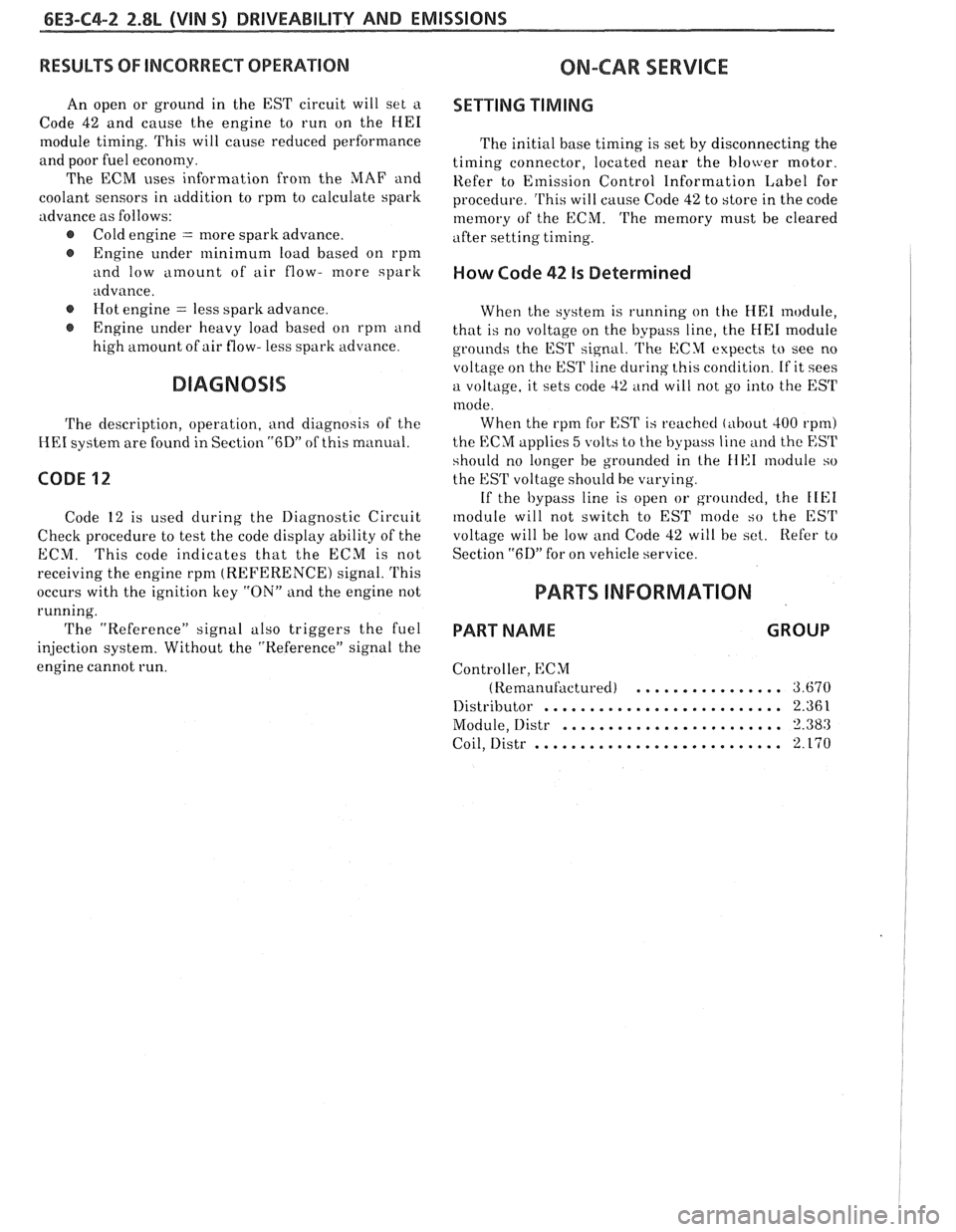
6E3-C4-2 2.8L (WIN S) DRIVEABILITY AND EMISSIONS
RESULTS OF INCORRECT OPERATION
An open or ground in the EST circuit will set a
Code 42 and cause the engine to run on the HE1
module timing. This will cause reduced performance
and poor fuel economy.
The ECM uses information from the
MAF and
coolant sensors in addition to rpm to calculate spark
~tdvance as follows:
@ Cold engine = more spark advance.
@ Engine under minimum load based on rpm
and low amount of air flow- more spark
advance. Hot engine
= less spark advance.
@ Engine under heavy load based on rprn and
high amount of air flow- less spark advance.
The description, operation, and diagnosis of the
HE1 system are found in Section "GD" of this manual.
CODE 12
Code 12 is used during the Diagnostic Circuit
Check procedure to test the code display ability of the
ECM. This code indicates that the ECM is not
receiving the engine
rpnl (REFERENCE) signal. This
occurs with the ignition key "ON" and the engine not
running.
The "Reference" signal also triggers the fuel
injection system. Without the "Reference" signal the
engine cannot run.
OM-CAR SERVICE
SETTING TIMING
The initial base timing is set by disconnecting the
timing connector, located near the blower motor.
Refer to Emission Control Information Label for
procedure.
This will cause Code 42 to store in the code
memory of the ECM.
The memory must be cleared
after setting timing.
How Code 42 Is Determined
When the system is running on the HE1 module,
that is no voltage on the bypass line, the
HE1 module
grounds the EST signal.
The ECk1 expects to see no
voltage
on the EST line during this condition. If it sees
a voltage, it sets code 42 and will not go into the EST
mode.
When the rpm for EST
is reachecl bout 300 rprn)
the ECM applies 5 volts to the bypass line and the E:SrI'
should no longer be grounded in the tIEI nodule so
the EST voltage should be varying.
If the bypass line is open or grounclecl, the IIEI
tnod~lle will not switch to EST mode so the EST
voltage will be low
and Code 42 will be set. Refer to
Section
"611" for on vehicle service.
PARTS INFORMATION
PART NAME GROUP
Controller, ECM
(Remanufi~ctured) ................ 3.670
.......................... Distributor 2.36 1
Module, Distr ........................ 3.380
........................... Coil, Distr 2.170
Page 861 of 1825
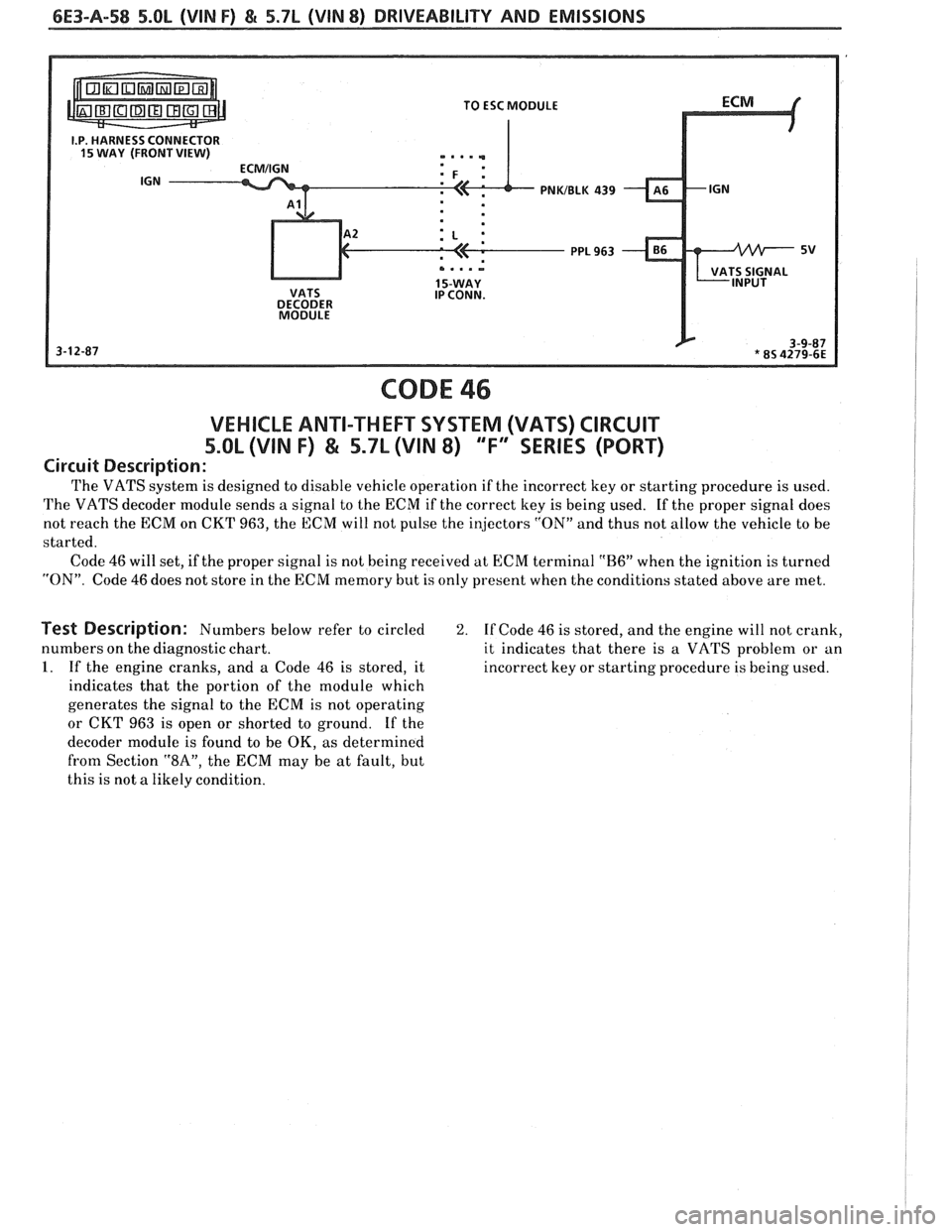
6E3-A-58 5.OL (VIN F) & 5.7L (VIN 8) DRIVEABILITY AND EMISSIONS
PNKIBLK 439
PPL 963
5V
IP CONN.
DECODER
MODULE
CODE 46
VEHICLE ANTI-THEFT SYSTEM (VATS) CIRCUIT
5.OL (VIN F) & 5.7L (VIN 8) 'TF'3SERlES (PORT)
Circuit Description:
The VATS system is designed to disable vehicle operation if the incorrect key or starting procedure is used.
The VATS decoder module sends a signal to the ECM if the correct key is being used. If the proper signal does
not reach the ECM on CKT 963, the ECM will not pulse the injectors
"ON" and thus not allow the vehicle to be
started.
Code
46 will set, if the proper signal is not being received at ECM terminal "B6" when the ignition is turned
"ON". Code 46 does not store in the ECM memory but is only present when the conditions stated above are met.
Test Description: Numbers below refer to circled 2. If Code 46 is stored, and the engine will not crank,
numbers on the diagnostic chart. it indicates that there is a VATS problem or an
1. If the engine cranks, and a Code 46 is stored, it incorrect key or starting procedure is being used.
indicates that the portion of the module which
generates the signal to the ECM is not operating
or CKT 963 is open or shorted to ground. If the
decoder module is found to be
OK, as determined
from Section
"8AV, the ECM may be at fault, but
this is not a likely condition.
Page 871 of 1825
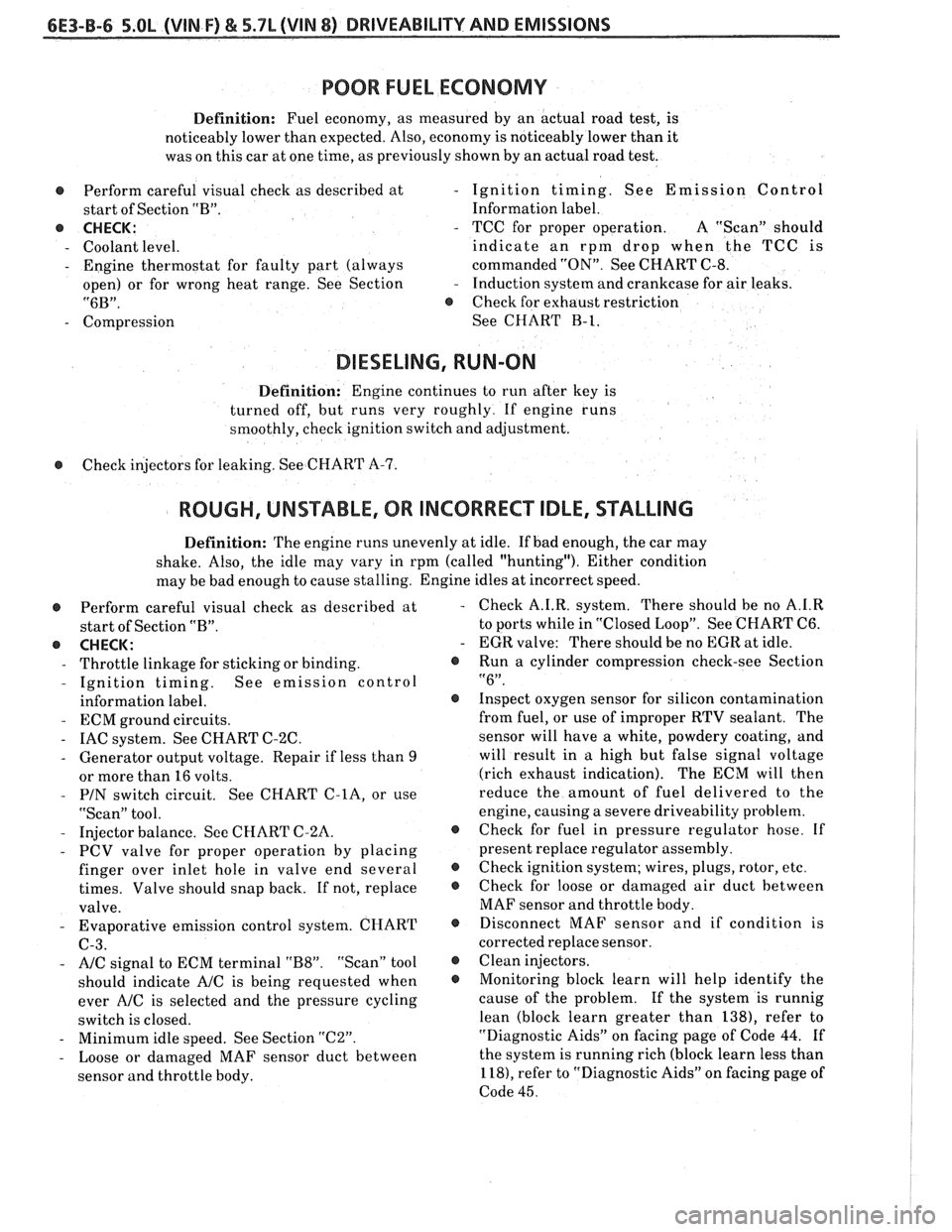
6E3-B-6 5.OL (VIN F) & 5.7L (VIN 8) DRIVEABILITY AND EMISSIONS
POOR FUEL ECONOMY
Definition: Fuel economy, as measured by an actual road test, is
noticeably lower than expected. Also, economy is noticeably lower than it
was on this car at one time, as previously shown by an actual road test.
@ Perform careful visual check as described at
start of Section "B".
@ CHECK:
- Coolant level.
- Engine thermostat for faulty part (always
open) or for wrong heat range. See Section
"6B".
- Compression
- Ignition timing. See Emission Control
Information label.
- TCC for proper operation. A "Scan" should
indicate an rpm drop when the TCC
is
commanded "ON". See CHART C-8.
- Induction system and crankcase for air leaks.
@ Check for exhaust restriction
See CHART
B-1.
DIESELING, RUN-ON
Definition: Engine continues to run after key is
turned off, but runs very roughly. If engine runs
smoothly, check ignition switch and adjustment.
@ Check injectors for leaking. See CHART A-7.
ROUGH, UNSTABLE, OR INCORRECT IDLE, STALLING
Definition: The engine runs unevenly at idle. If bad enough, the car may
shake. Also, the idle may vary in rpm (called "hunting"). Either condition
may be bad enough to cause stalling. Engine idles at incorrect speed.
@ Perform careful visual check as described at
start of Section "B".
e CHECK:
- Throttle linkage for sticking or binding.
- Ignition timing. See emission control
information label.
- ECM ground circuits.
- IAC system. See CHART C-2C.
- Generator output voltage. Repair if less than 9
or more than 16 volts.
- PIN switch circuit. See CHART C-lA, or use
"Scan" tool.
- Injector balance. See CHART C-2A.
- PCV valve for proper operation by placing
finger over inlet hole in valve end several
times. Valve should snap back. If not, replace
valve.
- Evaporative emission control system. CHART
C-3.
- A/C signal to ECM terminal "B8". "Scan" tool
should indicate
AIC is being requested when
ever
A/C is selected and the pressure cycling
switch is closed.
- Minimum idle speed. See Section "C2".
- Loose or damaged MAF sensor duct between
sensor and throttle body. Check
A.I.R. system. There should be no
A.1.R
to ports while in "Closed Loop". See CHART C6.
EGR valve: There should be no EGR at idle.
Run
a cylinder compression check-see Section
"6".
Inspect oxygen sensor for silicon contamination
from fuel, or use of improper RTV sealant. The
sensor will have a white, powdery coating, and
will result in a high but false signal voltage
(rich exhaust indication). The ECM will then
reduce the amount of fuel delivered to the
engine, causing a severe driveability problem.
Check for fuel in pressure regulator hose. If
present replace regulator assembly.
Check ignition system; wires, plugs, rotor, etc.
Check for loose or damaged air duct between
MAF sensor and throttle body.
Disconnect MAF sensor and if condition is
corrected replace sensor.
Clean injectors.
Monitoring block learn will help identify the
cause of the problem. If the system is runnig
lean (block learn greater than 1381, refer to
"Diagnostic Aids" on facing page of Code
44. If
the system is running rich (block learn less than
1 181, refer to "Diagnostic Aids" on facing page of
Code
45.
Page 916 of 1825
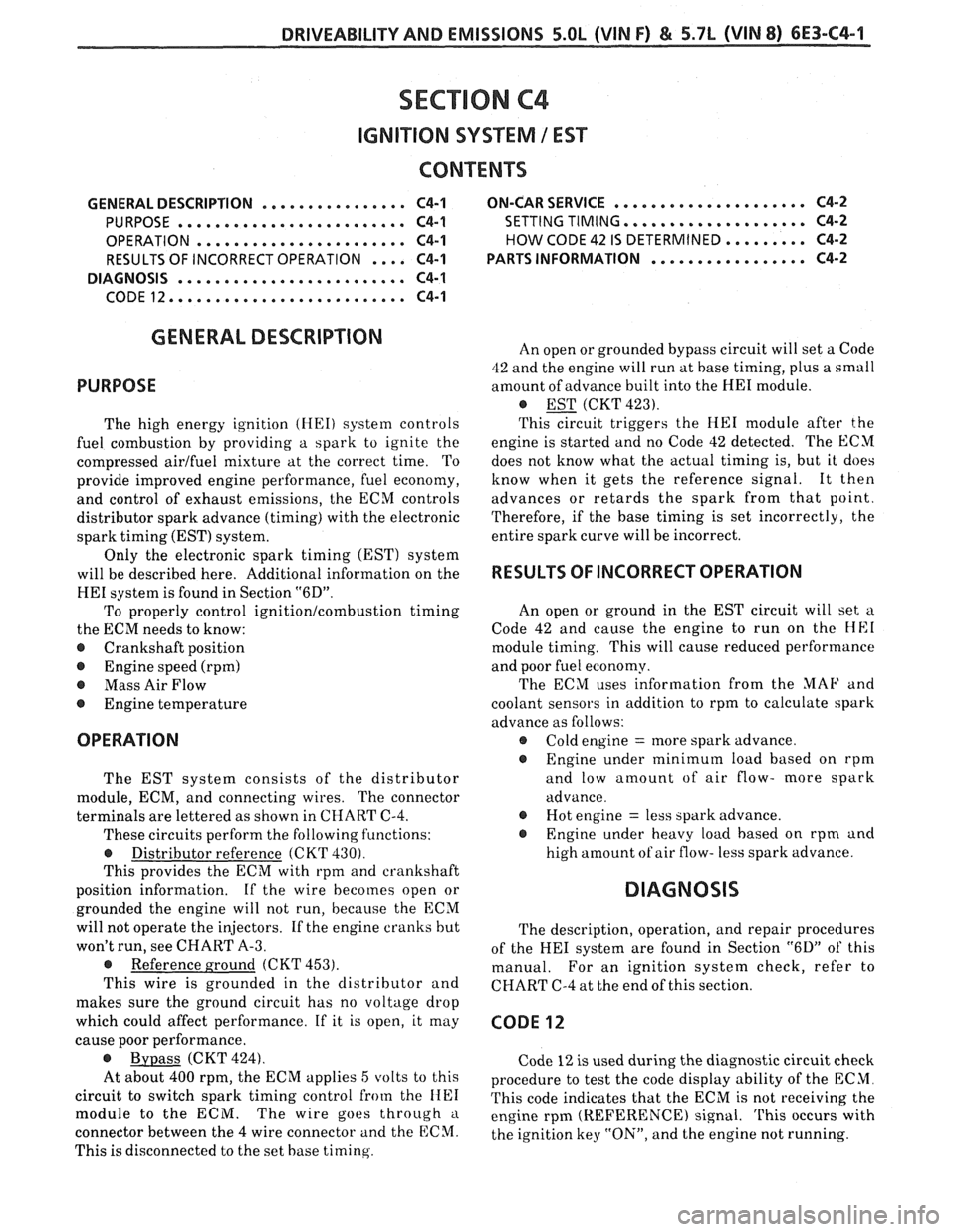
DRIVEABILITY AND EMISSIONS 5.OL (VIN F) & 5.7L (VIN 8) 6E3-C4-1
SECTION C4
IGNIION SYSTEM 1 EST
..................... GENERAL DESCRIPTION ................ C4-1 ON-CAR SERVICE C4-2
.................. PURPOSE ......................... C4-1 SETTING TIMING.. C4-2
OPERATION ....................... C4-1 HOW CODE 42 IS DETERMINED.. ....... C4-2
................. RESULTS OF INCORRECT OPERATION .... C4-1 PARTS INFORMATION C4-2
DIAGNOSIS ......................... C4-1
CODE12.......................... C4-1
GENERAL DESCRIPTION
PURPOSE
The high energy ignition (HEI) system controls
fuel combustion by providing a spark to ignite the
compressed
airlfuel mixture at the correct time. To
provide improved engine performance, fuel economy,
and control of exhaust emissions, the
ECM controls
distributor spark advance (timing) with the electronic
spark timing (EST) system.
Only the electronic spark timing (EST) system
will be described here. Additional information on the
FIE1 system is found in Section "6D".
To properly control ignitionlcombustion timing
the ECM needs to know:
e Crankshaft position
e Engine speed (rpm)
@ Mass Air Flow
@ Engine temperature
OPERATION
The EST system consists of the distributor
module, ECM, and connecting wires. The connector
terminals are lettered as shown in CHART C-4.
These circuits perform the following functions:
@ Distributor reference (CKT 430).
This provides the ECM with rpm and crankshaft
position information.
If the wire becomes open or
grounded the engine will not run, because the ECM
will not operate the injectors.
If the engine cranks hut
won't run, see CHART
A-3.
e Reference ground (CKT 453).
This wire is grounded in the distributor and
makes sure the ground circuit has no voltage drop
which could affect performance. If it is open, it may
cause poor performance.
@ Bvpass (CKT 424).
At about 400 rpm, the ECM applies
5 volts to this
circuit to switch spark timing control from the
I-IEI
module to the ECM. The wire goes through a
connector between the 4 wire connector and the ECM.
This is disconnected to the set hase timing. An
open or grounded bypass circuit will set a Code
42 and the engine will run at base timing, plus a small
amount of advance built into the
HE1 module.
@ EST (CKT 423). - This circuit triggers the HE1 module after the
engine is started and no Code 42 detected. The ECM
does not know what the actual timing is, but it does
know when it gets the reference signal. It then
advances or retards the spark from that point.
Therefore, if the base timing is set incorrectly, the
entire spark curve will be incorrect.
RESULTS OF INCORRECT OPERATION
An open or ground in the EST circuit will set u
Code 42 and cause the engine to run on the HE1
module timing. This will cause reduced performance
and poor fuel economy.
The ECM uses information from the
MAE' and
coolant sensors in addition to rpm to calculate spark
advance as follows:
e Cold engine = more spark advance.
r Engine under minimum load based on rpm
and low amount of air flow- more spark
advance. Hot engine
= less spark advance.
@ Engine under heavy load based on rpm and
high amount
of air flow- less spark advance.
DIAGNOSIS
The description, operation, and repair procedures
of the
HE1 system are found in Section "6D" of this
manual. For an ignition system check, refer to
CHART C-4 at the end of this section.
CODE 12
Code 12 is used during the diagnostic circuit check
procedure to test the code display ability of the
ECM
This code indicates that the ECM is not receiving the
engine rpm (REFERENCE) signal.
'Phis occurs with
the ignition key
"ON", and the engine not running.
Page 965 of 1825

6E-4 DRIVEABILITY AND EMISSIONS - FUEL INJECnON
and ohms. You should understand what happens in a
circuit with an open or a shorted wire. You should be
able to read and understand a wiring diagram. A
short to ground
is referred to as a ground to
distinguish it from a short between wires.
Use of Circuit Testing Tools
You should know how to use a test light, how to
connect and use
a tachometer, and how to use jumper
wires to by-pass components to test circuits. Care
should be taken to not deform the terminal when
testing.
Use of Digital Volt-Ohm Meter (DVM)
You should be familiar with the digital volt-ohm
Meter, particularly essential tool J-29125-A,
J34029A
or equivalent. You should be able to measure voltage,
resistance, and current, and know how to use the
meter correctly.
The digital volt-ohm meter is covered in the
"Special
ToolsJ'portion of this section.
DIAGNOSTIC INFORMATION
The electronic control module (ECM) is equipped
with a self-diagnosis system which detects system
failure and aids the technician by identifying the
circuit at fault via a trouble code. Below is
information about the way the ECM displays a
problem and how this corresponds to a trouble code in
the ECM. The ECM can also indicate an "Open Loop"
or "Closed Loop" mode.
"'Service Engine Soonw Light
This light is on the instrument panel, and has two
functions:
@ It is used to tell the driver that a problem has
occurred, and that the vehicle should be taken for
service as soon as reasonably possible.
@ It is used by the technician to read out "Trouble
CodesJ' to help diagnose system problems.
As a bulb and system check, the light will come
"ON" with the key "ON" and the engine not running.
When the engine is started, the light will turn "OFF".
If the light remains "ONJ', the self-diagnostic system
has detected a problem. If the problem goes away, the
light will go out in most cases after 10 seconds, but a
Trouble Code will remain stored in the ECM.
Intermittent "Service Engine Soon" Light
The diagnostic charts in Section "A" are set up to
check whether or not a stored trouble code is
"intermittent" or "hard". An
"intermittent" code is one which does not
always reset when the code setting parameters are
met, or is not present while you are working on the
vehicle. This is often caused by
a loose connection.
The facing page will contain diagnostic aids to help in
detecting
intermittents.
A "hard" code is one which is present when you
are working on the vehicle and the condition still
exists while working on the vehicle. The chart with
the stored trouble code number will lead you to the
cause of the problem.
Trouble Codes
The engine control module (ECM) is really a
computer. It uses sensors to look at many engine
operating conditions. It has
a memory and it knows
what certain sensor readings should be under certain
conditions. These conditions are described on the
facing page of each Trouble Code chart. If a sensor
reading is not what the ECM thinks it should be, the
ECM will turn "ON" the "Service Engine Soon" light
on the instrument panel, and will store a Trouble Code
in the memory. The Trouble Code tells which circuit
the trouble is in. A circuit consists of a sensor (such as
coolant temperature), the wiring and connectors to it,
and the ECM.
i
To get a Trouble Code out of the ECM, we use the
assembly line diagnostic link (ALDL) connector.
!
ALDL Connector I
I
The assembly line diagnostic link (ALDL) is a
diagnostic connector located in the passenger
compartment (Figure 2). It has terminals which are
used in the assembly plant to check that the engine is
operating properly before it leaves the plant.
Terminal "B" is the Diagnostic terminal, and it can be
connected to terminal
"A", or ground, to enter the
Diagnostic mode, or the Field Service Mode.
The ALDL connector is also used by "ScanJ' tools to
read information from the ECM via the Serial Data
Line. Serial Data information
is used extensively
throughout the manual.
Diagnostic Mode
1
If the Diagnostic terminal is grounded with the
ignition "ON" and the engine stopped, the system will
enter the Diagnostic Mode. In this mode the ECM
will:
1. Display a Code 12 by flashing the "Service Engine
Soon" light (indicating the system is operating). A
Code 12 consists of one flash, followed by a short
pause, then two flashes in quick succession. This
code will be flashed three times. If no other codes
Page 966 of 1825
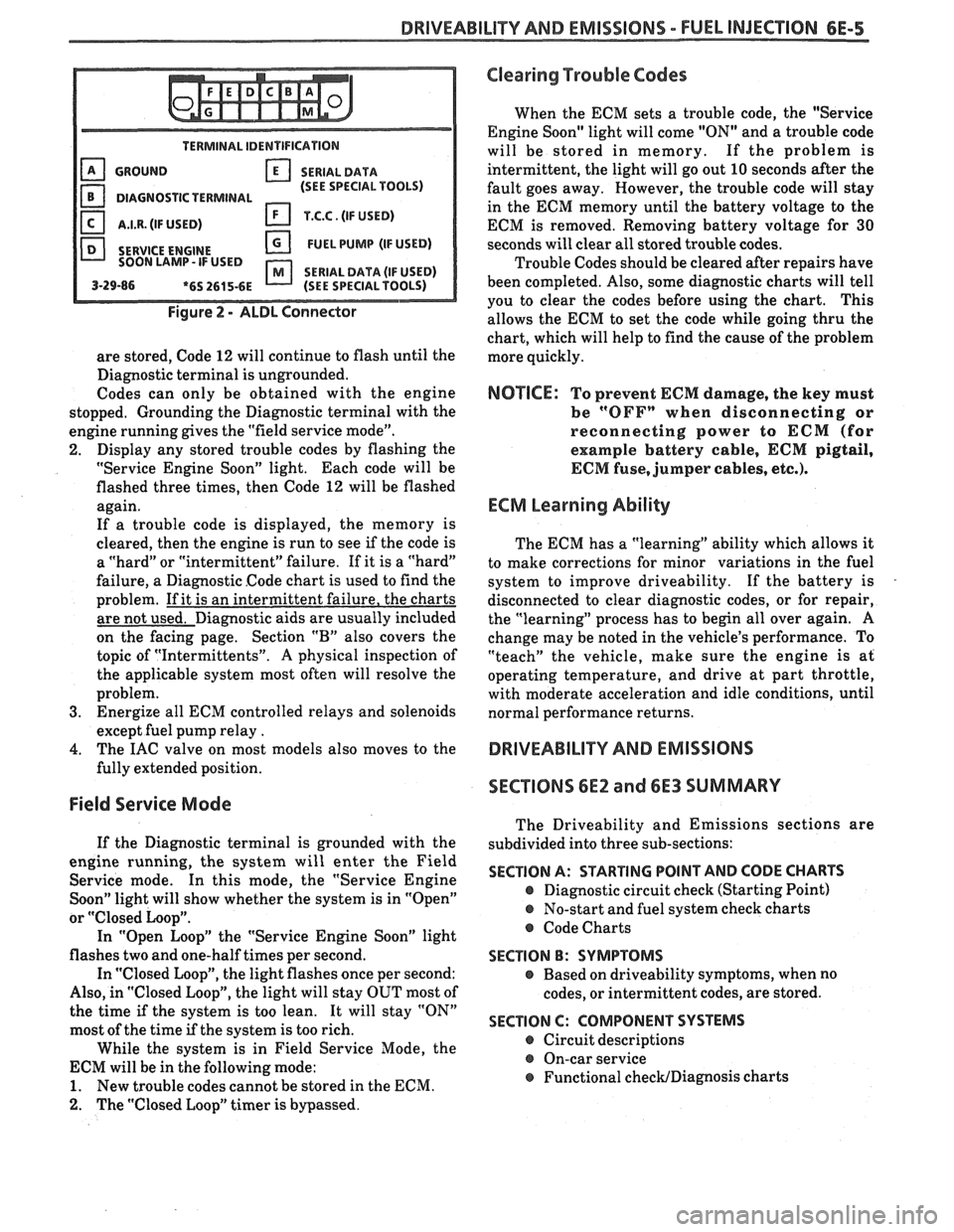
DRIVEABILITY AND EMISSIONS - FUEL INJECTION 6E-5
TERMINAL IDENTIFICATION
GROUND SERIALDATA
(SEE SPECIAL TOOLS)
DIAGNOSTIC TERMINAL
I.I.R. (IF USED) T.C.C. (IF USED)
SERVICE
ENGINE FUEL PUMP (IF USED)
SOON LAMP- IF USED
SERIAL DATA (IF USED) 3-29-86 *6S 2615-6E (SEE SPECIAL TOOLS)
Figure 2 - ALDL Connector
are stored, Code 12 will continue to flash until the
Diagnostic terminal is ungrounded.
Codes can only be obtained with the engine
stopped. Grounding the Diagnostic terminal with the
engine running gives the "field service mode".
2. Display any stored trouble codes by flashing the
"Service Engine Soon" light. Each code will be
flashed three times, then Code
12 will be flashed
again.
If a trouble code is displayed, the memory is
cleared, then the engine is run to see
if the code is
a "hard" or "intermittent" failure. If it is a "hard"
failure, a Diagnostic Code chart is used to find the
problem. If it is an intermittent failure, the charts
are not used. Diagnostic aids are usually included
on the facing page. Section
"B" also covers the
topic of "Intermittents".
A physical inspection of
the applicable system most often will resolve the
problem.
3. Energize all ECM controlled relays and solenoids
except fuel pump relay
.
4. The IAC valve on most models also moves to the
fully extended position.
Field Service Mode
If the Diagnostic terminal is grounded with the
engine running, the system will enter the Field
Service mode. In this mode, the "Service Engine
Soon" light will show whether the system is in "Open"
or
"Closed Loop".
In "Open Loop" the "Service Engine Soon" light
flashes two and one-half times per second.
In "Closed Loop", the light flashes once per second:
Also, in "Closed Loop", the light will stay OUT most of
the time
if the system is too lean. It will stay "ON"
most of the time if the system is too rich.
While the system is in Field Service Mode, the
ECM will be in the following mode:
1. New trouble codes cannot be stored in the ECM.
2. The "Closed Loop" timer is bypassed.
Clearing Trouble Codes
When the ECM sets a trouble code, the "Service
Engine Soon" light will come "ON" and a trouble code
will be stored in memory. If the problem is
intermittent, the light will go out
10 seconds after the
fault goes away. However, the trouble code will stay
in the ECM memory until the battery voltage to the
ECM is removed. Removing battery voltage for
30
seconds will clear all stored trouble codes.
Trouble Codes should be cleared after repairs have
been completed. Also, some diagnostic charts will tell
you to clear the codes before using the chart. This
allows the ECM to set the code while going thru the
chart, which will help to find the cause of the problem
more quickly.
NOTICE: To prevent ECM damage, the key must
be
"OFFn when disconnecting or
reconnecting power to
ECM (for
example battery cable,
ECM pigtail,
ECM fuse, jumper cables, etc.).
ECM Learning Ability
The ECM has a "learning" ability which allows it
to make corrections for minor variations in the fuel
system to improve driveability. If the battery is
disconnected to clear diagnostic codes, or for repair,
the "learning" process has to begin all over again.
A
change may be noted in the vehicle's performance. To
"teach" the vehicle, make sure the engine is at
operating temperature, and drive at part throttle,
with moderate acceleration and idle conditions, until
normal performance returns.
DRIVEABILITY AND EMISSIONS
SECTIONS
6E2 and 6E3 SUMMARY
The Driveability and Emissions sections are
subdivided into three sub-sections:
SECTION A: STARTING POINT AND CODE CHARTS
@ Diagnostic circuit check (Starting Point)
@ No-start and fuel system check charts
@ Code Charts
SECTION B: SYMPTOMS
e Based on driveability symptoms, when no
codes, or intermittent codes, are stored.
SECTION C: COMPONENT SYSTEMS
@ Circuit descriptions
@ On-car service
@ Functional checWDiagnosis charts
Page 968 of 1825
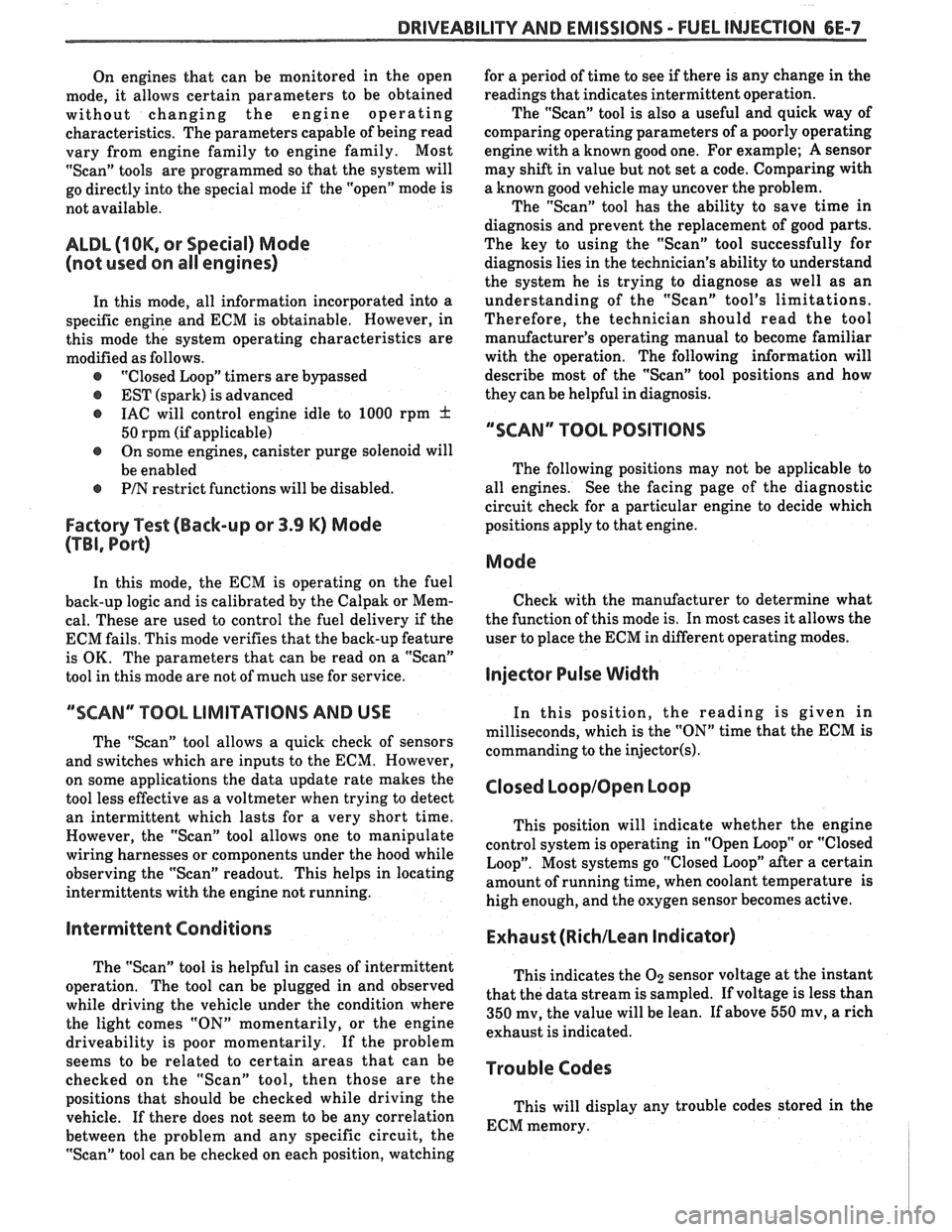
DRIVEABILITY AND EMISSIONS - FUEL INJECTION 6E-7
On engines that can be monitored in the open
mode, it allows certain parameters to be obtained
without changing the engine operating
characteristics. The parameters capable of being read
vary from engine family to engine family. Most
"Scan" tools are programmed so that the system will
go directly into the special mode
if the "open" mode is
not available.
ALDL (7 OK, or Special) Mode
(not used on
all engines)
In this mode, all information incorporated into a
specific
engine and ECM is obtainable. However, in
this mode the system operating characteristics are
modified as follows.
@ "Closed Loop" timers are bypassed
EST (spark) is advanced
@ IAC will control engine idle to 1000 rpm I
50 rpm (if applicable)
@ On some engines, canister purge solenoid will
be enabled
@ P/N restrict functions will be disabled.
Factory Test (Back-up or 3.9 K) Mode
(TBI, Port)
In this mode, the ECM is operating on the fuel
back-up logic and is calibrated by the Calpak or Mem-
cal. These are used to control the fuel delivery
if the
ECM fails. This mode verifies that the back-up feature
is OK. The parameters that can be read on a
"Scan"
tool in this mode are not of much use for service.
"SCAN" TOOL LIMITATIONS AND USE
The "Scan" tool allows a quick check of sensors
and switches which are inputs to the ECM. However,
on some applications the data update rate makes the
tool less effective as a voltmeter when trying to detect
an intermittent which lasts for a very short time.
However, the "Scan" tool allows one to manipulate
wiring harnesses or components under the hood while
observing the "Scan" readout. This helps in locating
intermittents with the engine not running.
intermittent Conditions
for a period of time to see if there is any change in the
readings that indicates intermittent operation.
The "Scan" tool is also a useful and quick way of
comparing operating parameters of a poorly operating
engine with a known good one. For example;
A sensor
may shift in value but not set a code. Comparing with
a known good vehicle may uncover the problem.
The "Scan" tool has the ability to save time in
diagnosis and prevent the replacement of good parts.
The key to using the "Scan" tool successfully for
diagnosis lies in the technician's ability to understand
the system he is trying to diagnose as well as an
understanding of the "Scan" tool's limitations.
Therefore, the technician should read the tool
manufacturer's operating manual to become familiar
with the operation. The following information will
describe most of the "Scan" tool positions and how
they can be helpful in diagnosis.
"SCAN" TOOL POSITIONS
The following positions may not be applicable to
all engines. See the facing page
of the diagnostic
circuit check for a particular engine to decide which
positions apply to that engine.
Mode
Check with the manufacturer to determine what
the function of this mode is. In most cases it allows the
user to place the ECM in different operating modes.
Injector Pulse Width
In this position, the reading is given in
milliseconds, which is the
"ON" time that the ECM is
commanding to the
injector(s1.
Closed LoopIOpen Loop
This position will indicate whether the engine
control system is operating in "Open Loop" or "Closed
Loop". Most systems go "Closed Loop" after a certain
amount of running time, when coolant temperature is
high enough, and the oxygen sensor becomes active.
Exhaust (RichILean Indicator)
The "Scan" tool is helpful in cases of intermittent
This indicates the O2 sensor voltage at the instant operation' The can be in and observed that the data stream is sampled. If voltage is less than
while driving the vehicle under the condition where
350 mv, the value will be lean. If above 550 mv, a rich the light comes "ON" momentarily, or the engine exhaust is indicated. driveability is poor momentarily. If the problem
seems to be related to certain areas that can be
Codes checked on the "Scan" tool, then those are the
positions that should be checked while driving the
This will display any trouble codes stored in the
vehicle. If there does not seem to be any correlation
ECM memory. between the problem and any specific circuit, the
"Scan" tool can be checked on each position, watching